So, corwin and I went to Paris (yes, France) in December 2021, to celebrate our 30th anniversary and also to celebrate our latest booster shots and go somewhere that still had COVID regulations in place that made sense to us. (Of course we know so much more now about re-infection and all, but this post is not about that.) At the time I posted a long twitter thread with lots of photos but who knows if Twitter is even going to be around or functional soon, so I’m reposting here, with some tweaks for blog format:
So, the big thing that got us out of our semi-quarantine and all the way to Paris was some friends invited us to join them for what promised to be a stellar meal, a tasting menu worthy of corwin and my 30th anniversary. So, yes, here is a food porn thread!
It’s my first time in Paris, and we had been here a few days already before the night of the big dinner, but hadn’t made it over toward the Eiffel Tower yet. We took the Metro from our hotel in the 11th arrondissement and came up to a stunning view.

The Eiffel Tower at night, across a moonlit river Seine, is pretty hard to beat. Our destination was just across the water, where a couple of the world’s most decorated chefs have set up for 100 nights. You can’t really call that a “pop up,” can you?
Alain Ducasse, the current leader in most Michelin stars, Albert Adria, of el Bulli fame, and some of their associates, collaborated on this unique gastronomical effort and they dubbed it ADMO and situated it in the Musee du Jacques Chirac.
I’d love to talk about nothing but the food, but really it’s not possible to discuss the meal or ADMO without the context, and that context is COVID and the tremendous impact on the restaurant industry, on travel, on the food supply, and on how people gather.
It's my first time in Paris, and we'd been here a few days already before the night of the big dinner, but hadn't made it over toward the Eiffel Tower yet. We took the Metro from our hotel in the 11th arrondissement and came up to a stunning view. pic.twitter.com/pkbXlaNwwB
— Cecilia Tan (@ceciliatan) December 13, 2021
“Eating out” is a major part of our lives. But we didn’t set foot in a restaurant (except to scurry in to grab a take-out bag) from March 13 2020 to April 8 2021. In the summer we took to patio dining. But then winter arrived, and we finally moved indoors.
Once we started eating indoors again, it was not that big a mental leap to decide if it’s okay to eat in a nice restaurant in Boston, why not in France? (It’s probably even safer in France given that you have to show your “pass sanitaire” to do so!) [Author’s note: this was before the Omicron wave. After we returned to the States, we stopped eating indoors again for the rest of the winter.]
It’s not just that we like having someone else do the cooking and cleaning, either. Sharing a communal dining experience is itself a thing. And the ephemeral nature of ADMO emphasizes that communal nature: you’re only going to have this chance to do it once.
In that way, the sense of restaurant as theater is heightened. It’s like wanting to see a Broadway show with the original cast, knowing that a show like Hamilton caught lightning in a bottle, and that every night’s performance is unique and to be savored.
After our year of no restaurants (and no theater, no live concerts, no travel, etc) we were especially keen to leap at this chance. The ephemeral nature of the dining experience wasn’t explicitly stated part of the ADMO theme, but I couldn’t help but feel it.
(I’m getting to the photos of the dishes, I promise.)
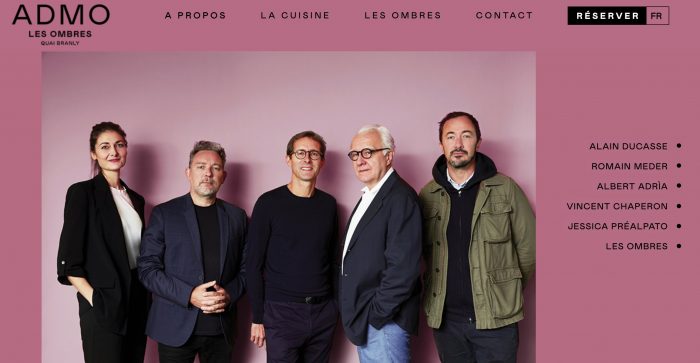
The site for ADMO was a restaurant, Les Ombres, that has presumably been lying fallow during the worst of COVID, so who knows if without the pandemic this “pop up” would even have come together? And what a space: a glass-roofed atrium with Eiffel Tower view!

At 7:30 we were seated. Only two other tables were that early, meaning we had the nearly undivided attention of a small army of waitstaff and sommeliers at the start. Our party of 7 decided on a wine budget and told the sommelier to pair freely within it.
I regret I didn’t actually get a list of the wines or remember to take photos of all the bottles. (A friend did, though… I think he may have posted a reply in the tweet thread…) They were all exquisite. A pairing should always enhance the food’s flavor, but in this case I felt like in particular the note being enhanced was the *salinity.*
The theme of salinity played throughout the meal. I hesitate to use the word “salty,” which has negative connotations. Usually if the saltiness of food is remarked on, it’s to say it’s “too salty,” or we equate salty food with junk food. This was not that!
The amuse-bouche was “shadows and light,” a juxtaposition of black & white liquids: pressed caviar and celeriac-almond milk. The caviar essence is a deep umami and the salinity of the sea, while the celeriac-almond is the opposite: creamy and a touch vegetal.
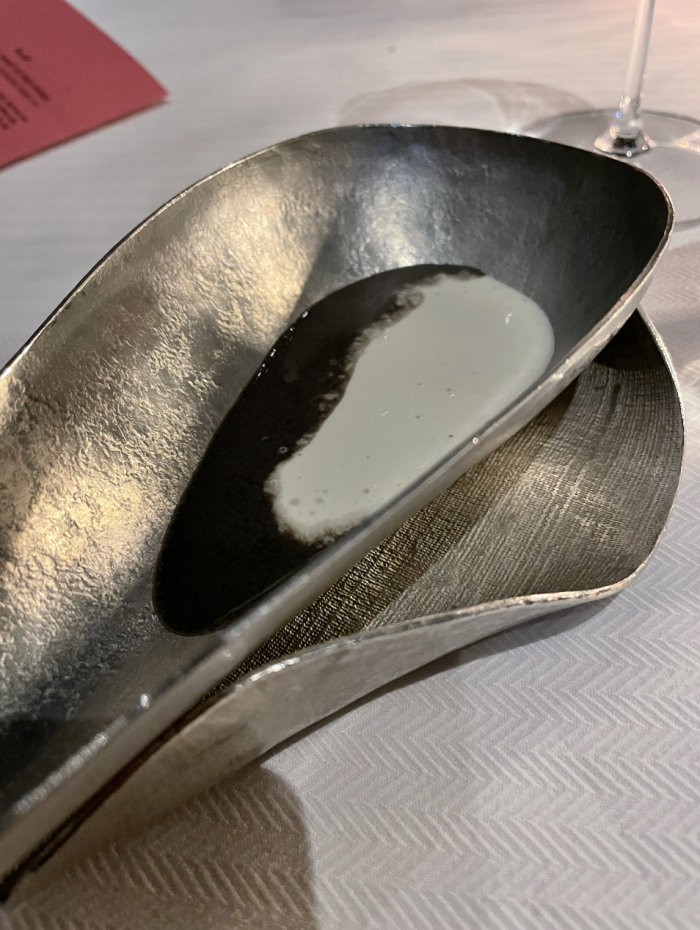
The shadows and light were served in a boat as long and elegant as a greyhound’s snout, that you picked up in hand and just poured the liquids into your mouth. It reminded me of my mom letting me drink the gravy right from the gravy boat at the end of a holiday meal as a kid! Delicious, playful, and pure.
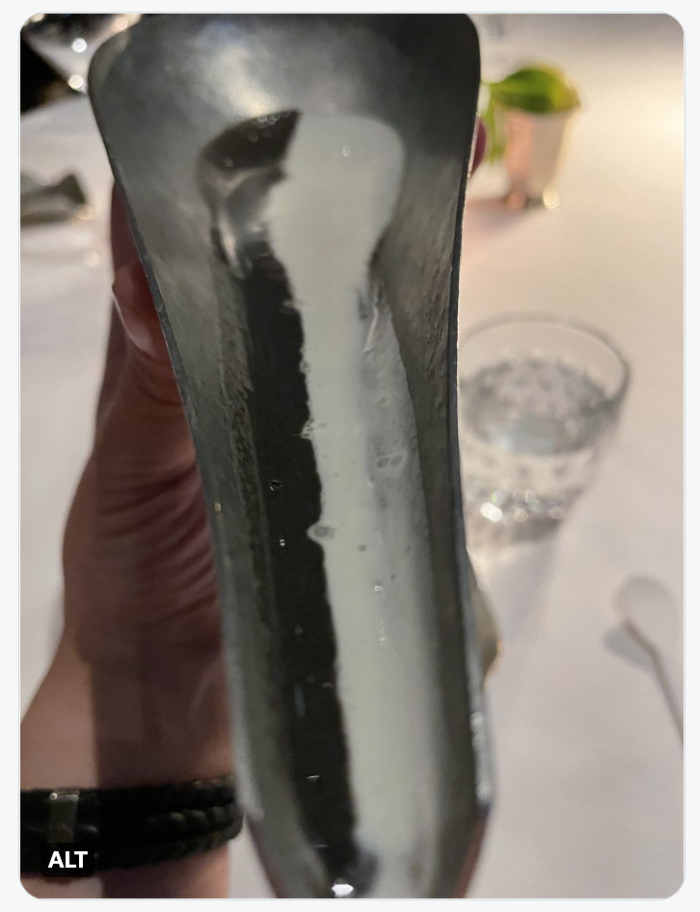
As if to announce the opening act was about to arrive, the Eiffel Tower then lit up like a giant sparkler, accompanied by twinkling lights inside the restaurant! An unexpected magical touch.
As if to announce the opening act was about to arrive, the Eiffel Tower then lit up like a giant sparkler, accompanied by twinkling lights inside the restaurant! An unexpected magical touch. pic.twitter.com/dPb0WmMqSN
— Cecilia Tan (@ceciliatan) December 13, 2021
Another opening bite was a contrast to the all-liquid amuse, a cracker (cracked at the table) made of whole seeds, just barely held together by whatever starch or flour there was, as textured as a cobblestoned street.
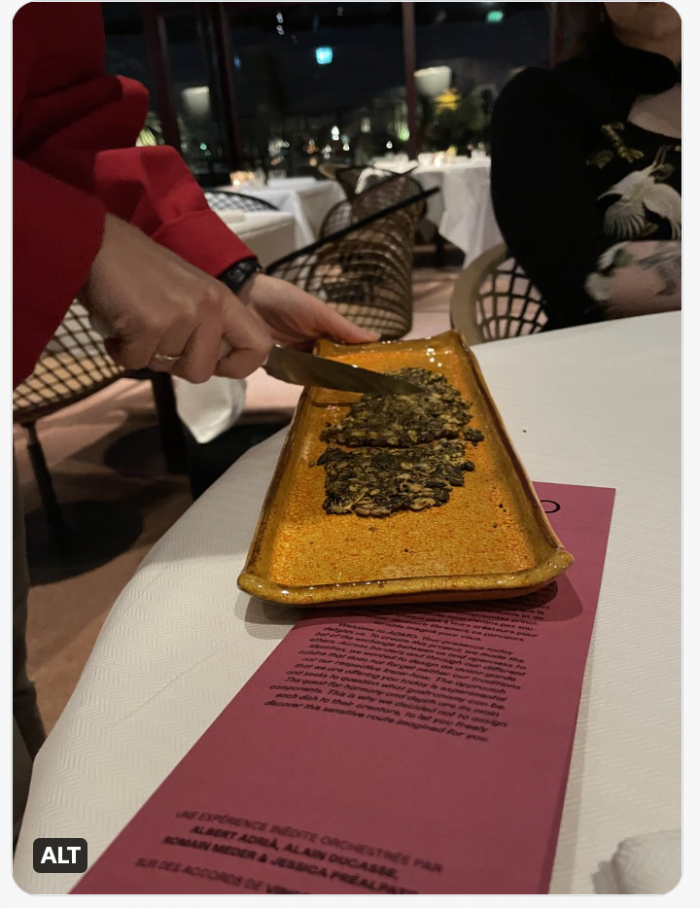
The main flavor in the cracker was the earthiness of the seeds, extremely crunchy and satisfying to bite on. (The menu listed 5 amuses and 2 hors d’ouvres, but they were not served in the exact order listed, kind of mixing and matching.)
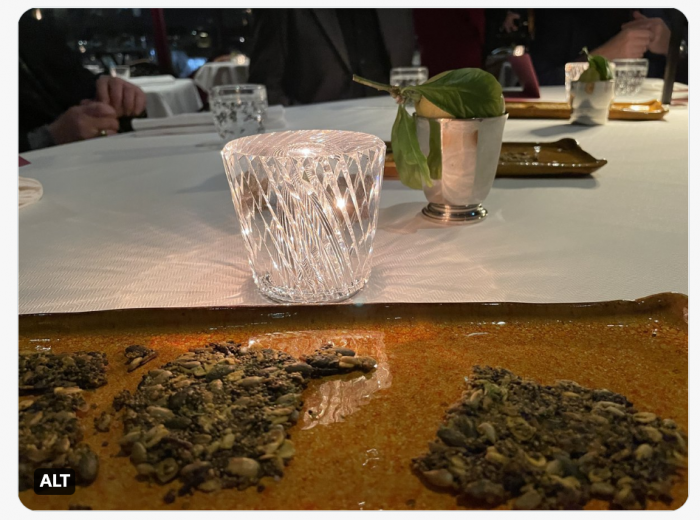
Then came something with truffle. November/December is white truffle season, and this means that when corwin and I go out to celebrate our anniversary there is nearly always something with truffle. Et voila!
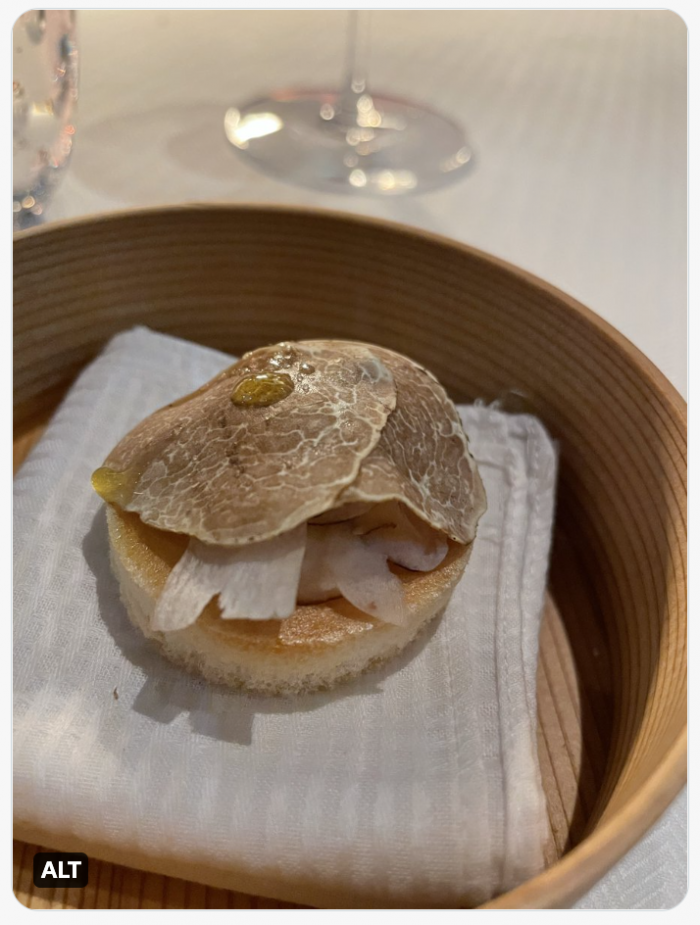
It looks like it’s on a cracker or round bit of bread, but it’s actually meringue! With “Brillat-Savarin cheese cream, shaved Paris mushrooms, and tartufi di Alba “(white truffle). Also shown here: the finger towel since the amuses were mostly finger foods.
Another amuse in a wooden bowl: described as shaved salsify, mustard, miso, and ginger confit, and apparently held together with magic…? Who knew you could confit ginger?
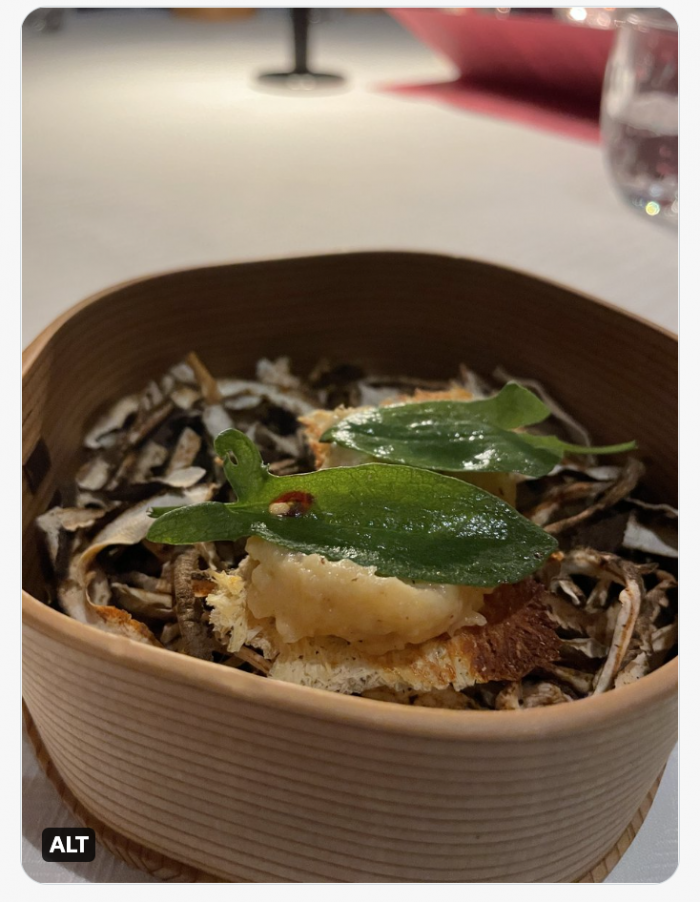
Another amuse: oyster sausage. I have never before had oyster sausage, but it’s the only way I’ve ever had cooked oyster that preserved what’s wonderful about raw oyster: the mixture of creaminess with brine. (Just like the shadows and light..) A revelation.
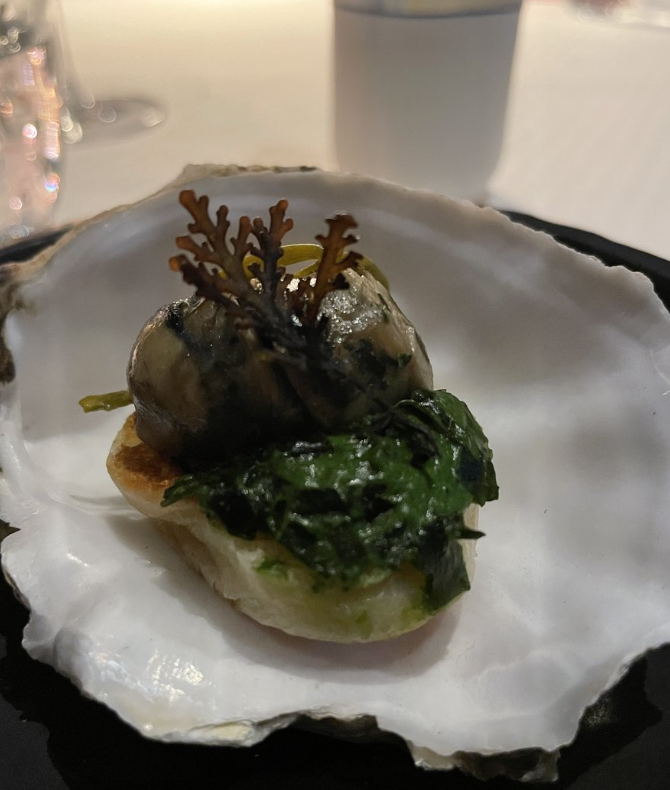
I didn’t read the menu during the meal, preferring to just experience the food rather than read about it (especially given the long and voluminous descriptions — I’d rather hear the details from the waitstaff and be able to pepper them with questions), but I’ll use it now to fill in details! The dish of vetch listed was served alongside the scallop dish, but I didn’t get a photo of the side dish.
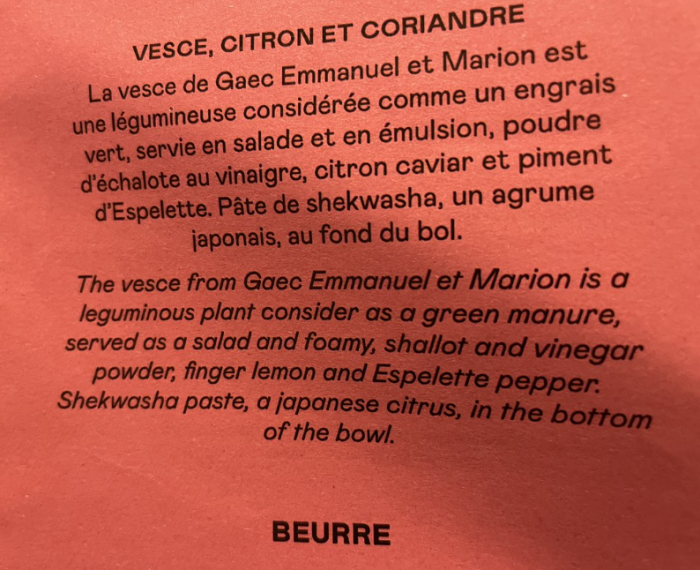
The English on this reads: “The Vesce (vetch) from Gaec Emmanuel et Marion is a leguminous plant consider as a green manure, served as a salad and foamy, shallot and vinegar powder, finger lemon and Espelette pepper. Shekwasha paste, a japanese citrus, in the bottom of the bowl.”
Another quote from the menu: “Brine sea scallops from Seine bay, quick seared, topped with toum, traditional Lebanese recipe with garlic, burnt lemon and breaded with puffed quinoa. Served with confit shallot, an onion, sea scallop liver, squid ink, heart of smoked tuna and a burnt onion extraction sauce.”
Some of the translation from French to English I might quibble with, but you get the idea when a description of a dish doesn’t fit in one tweet. Scallops, of course, are a seafood, but they are all about sweetness.
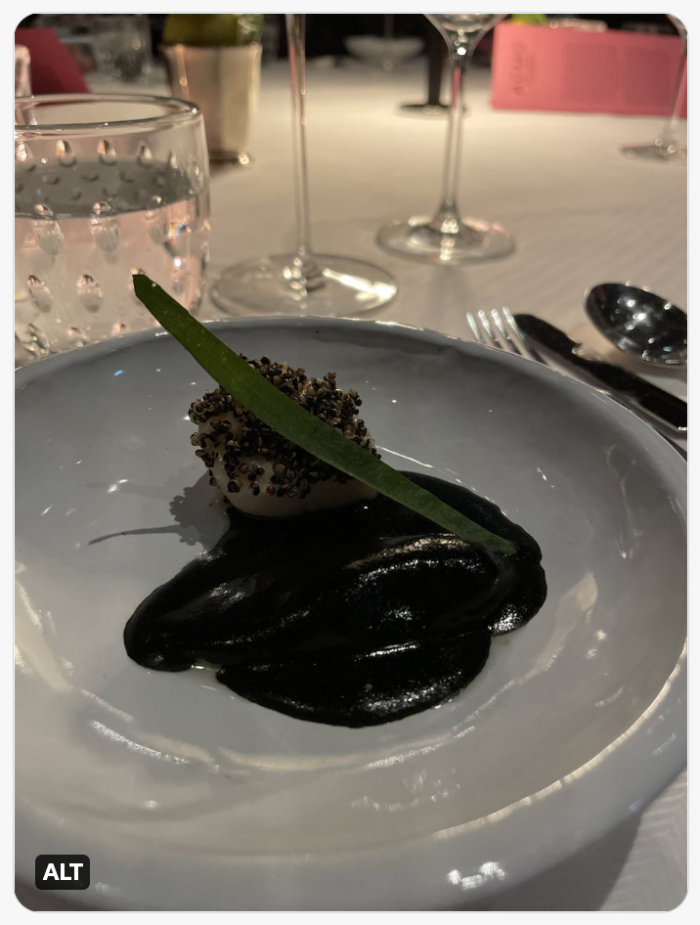
So here we have that theme again, the white, sweet scallop contrasted with this incredible sauce, black with squid ink and full of rich depth of flavor from the toum. I licked the plate.
Next: a tart levitating on air! (There’s a film of plastic you can’t see…) A tiny pastry shell, filled with raw gamberoni from San Remo and topped with two teensy tiny white chevrettes (shrimps). With a coral emulsion.
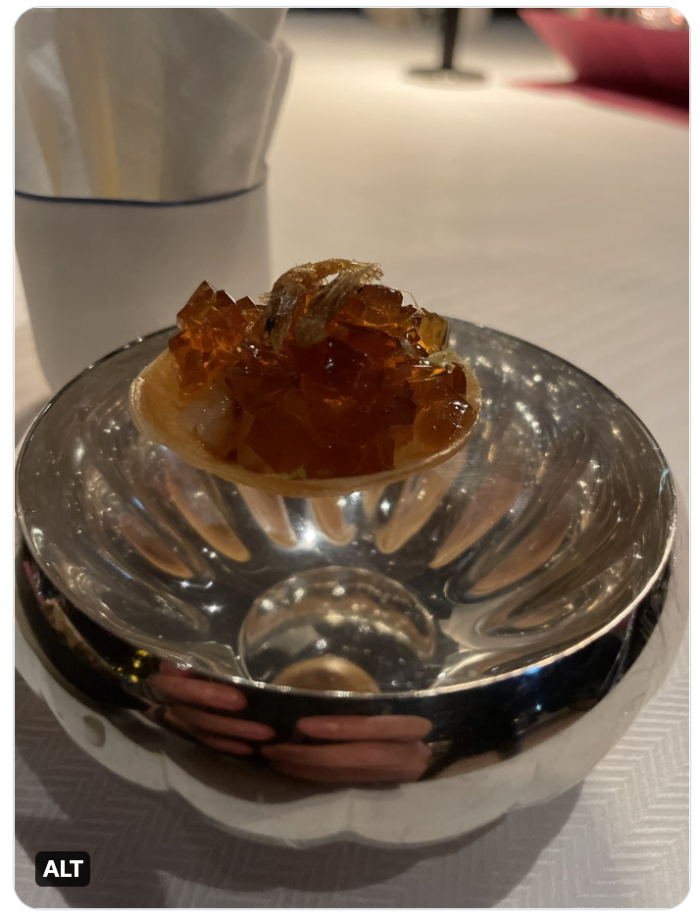
I believe I cribbed this photo from one of our dinnermates because mine still had the decorative leaf on top, and the chevrettes were so tiny they were hidden under it.
For our Thanksgiving dinner this year (2021), we made the theme “togetherness,” (&) and served all courses with names like “Soup & Sandwich” or “Peanut Butter & Jelly”. One was “Bread & Butter” which was literally fresh baked sourdough with homemade herb & honey butters.
Having people literally breaking apart bread and then slathering it with butter was not only fun, it had a serious comfort component to it. There’s something so satisfying and comforting about eating bread with butter. And ADMO did this too!
ADMO served a “Beurre” (butter) course! The breads were interesting though, one was rice flour and beeswax, and the other was a rice flour focaccia with olives. The butter came on a wooden spoon and I used every bit of it.
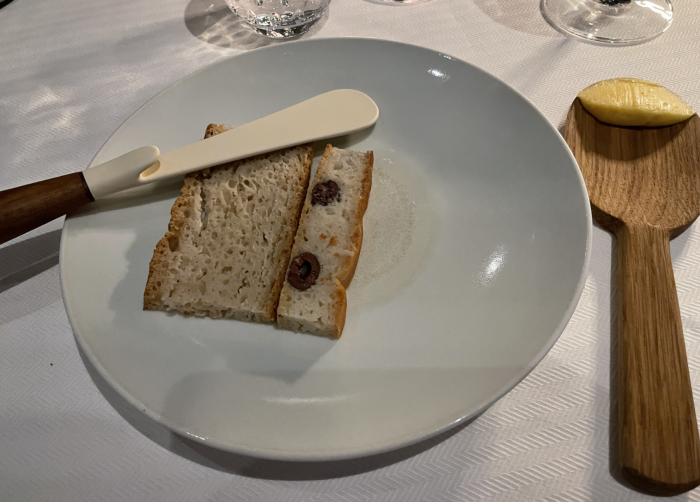
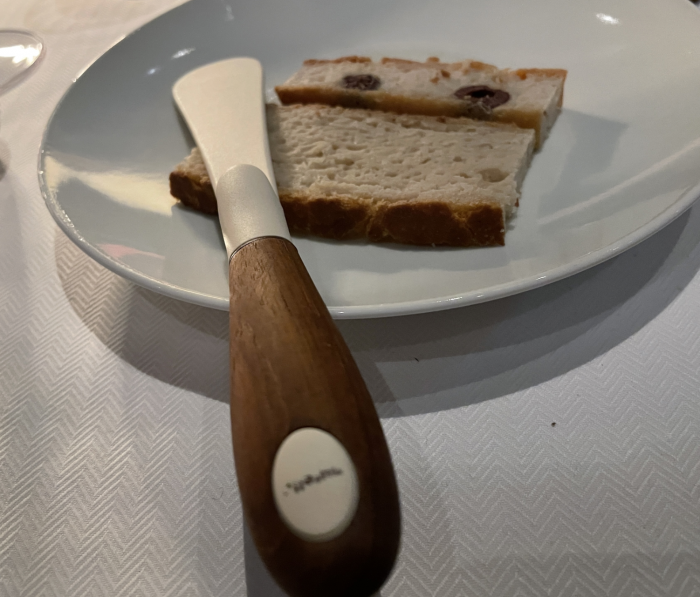
From there, we moved to the “entrees” which in French cuisine means “first courses” and not “main dishes” (“plat” is “main dish”). This is “soba” made of salted cod skin, with mushrooms, sea urchin, and quail egg. Not quite Asian, but quite delicious.
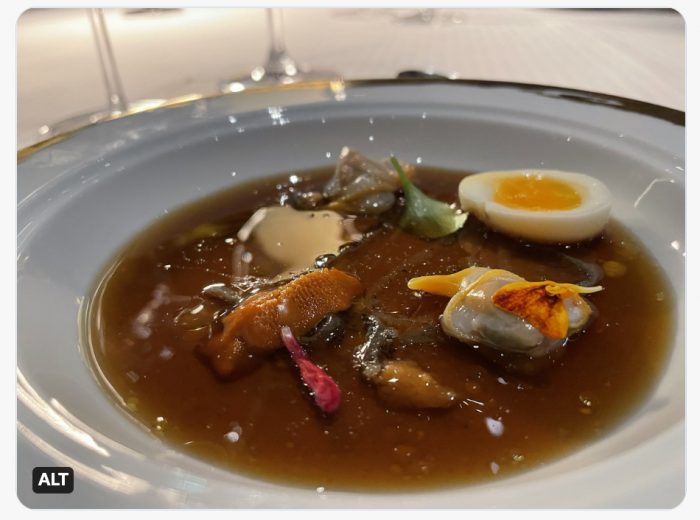
Then came something amazing: sea cucumber. In Spain we once ate at Via Veneto, and the maitre d’ there explained that two cultures eat the sea cucumber: the Spanish and the Chinese. But they eat two totally different parts of the sea cucumber.
The Chinese eat the rubbery exterior. The Spanish eat the unctuous, gooey-chewy interior. This dish used the interior, with chickpeas, confit garlic, celery leaves, and topped with caviar. My favorite dish of the night.
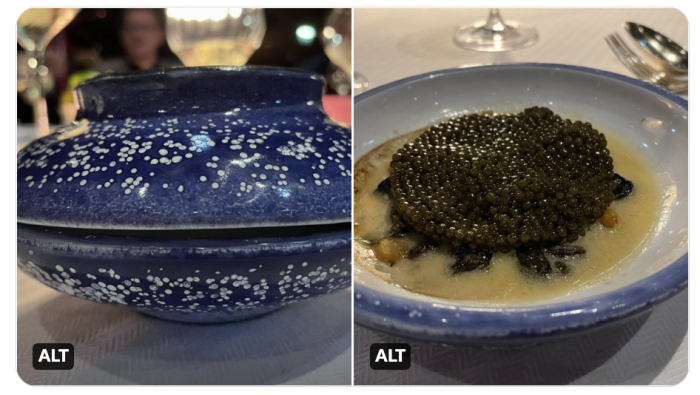
Two main dishes still to come, but I should mention again the theme of salinity. With so many types of seafood, it was like we experienced as many different kinds of salinity as there are oceans. We had a wine that reminded me of green apple with burnt sugar.
Main dish #1: blue lobster. The English on the menu does not do the dish justice: “blue lobster dried on the ember, fermented raw turnip. Lobster claws turnip spices and coral emulsion condiment. Slice of turnip like black garlic.”
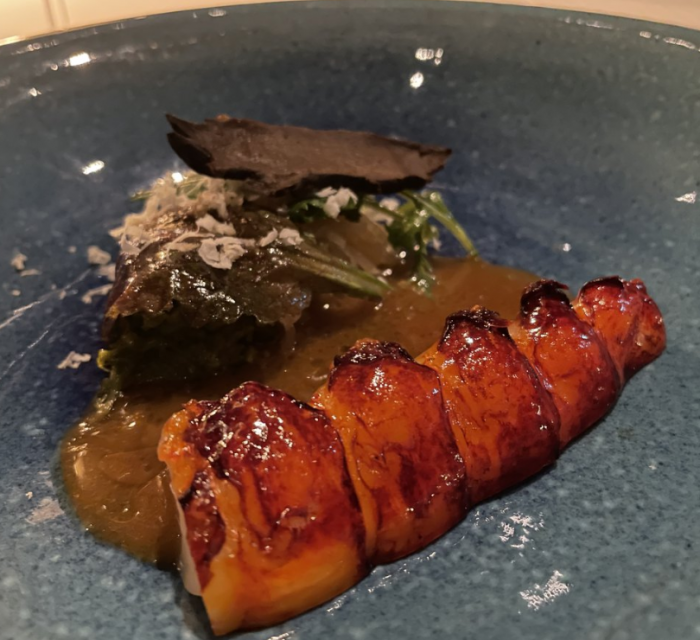
Main dish #2: confit monkfish liver and black sesame paste, served with a mexican-style molé of spices and black garlic, “with a cauliflower in salt, then dehydrated and rehydrated in the leaf juice (??) roasted with brown butter.”
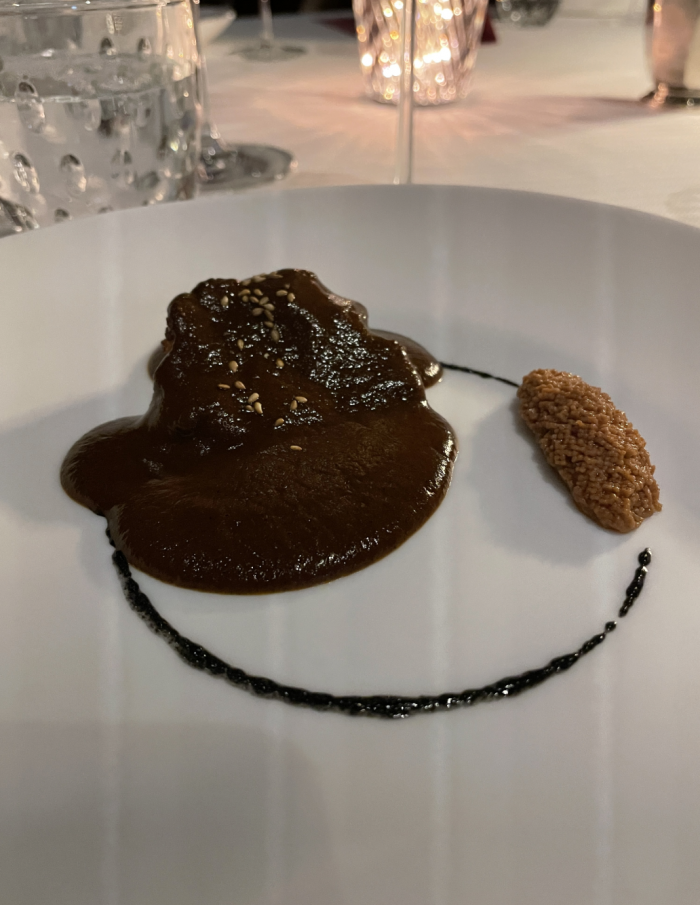
The cauliflower was great, even if the description in the menu sounds a bit sus. And monkfish liver is always delicious, somewhat similar to sea urchin.
As is traditional, a cheese plate was served after the main dishes and before dessert. This special cheese was apparently aged just for ADMO, “made of Salers cow milk only when their veal are with them!” (They mean calf, I swear) With oxydated (? – they must mean oxidized?) quince.
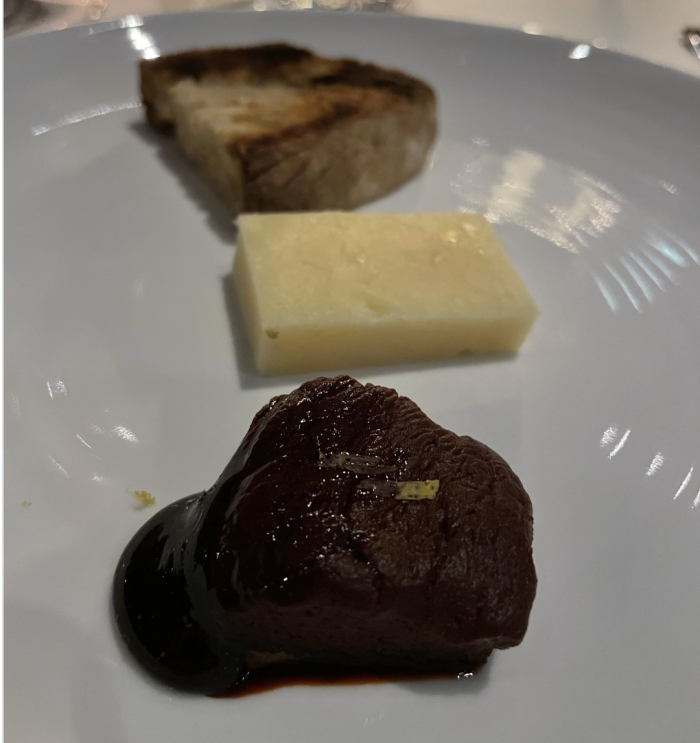
Two desserts followed, created by Jessica Prealpato and Albert Adria, but not described on the menu. This first one was like a granita made out of beer with apples? quinces? Not overly sweet, and nicely refreshing.
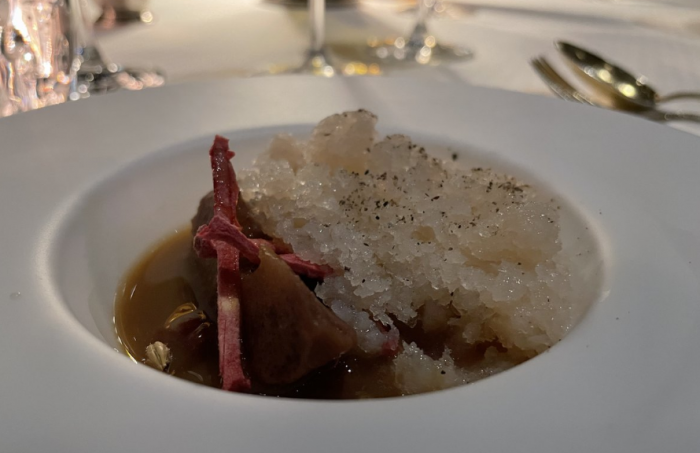
Then came an ice cream with paper-thin crispy chocolate leafs on top and I no longer remember what was underneath it… I really should have taken notes but I was into enjoying the food & company more than scribbling things down. 🙂
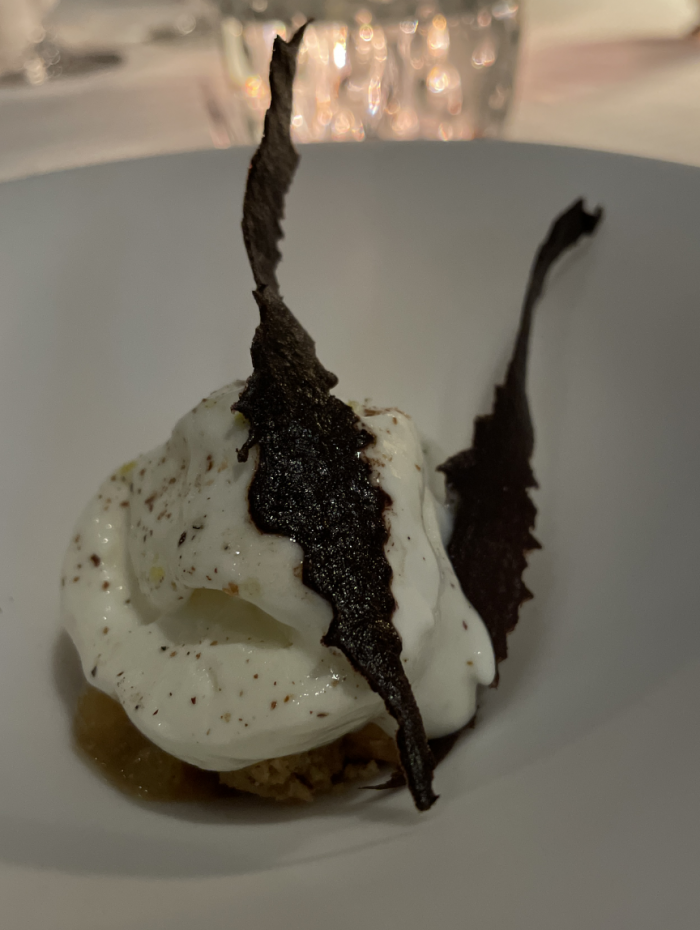
This was less of a dessert than it was a palate cleanser: a yellow kiwi, pre-cut inside its skin for ease of eating with the fork.
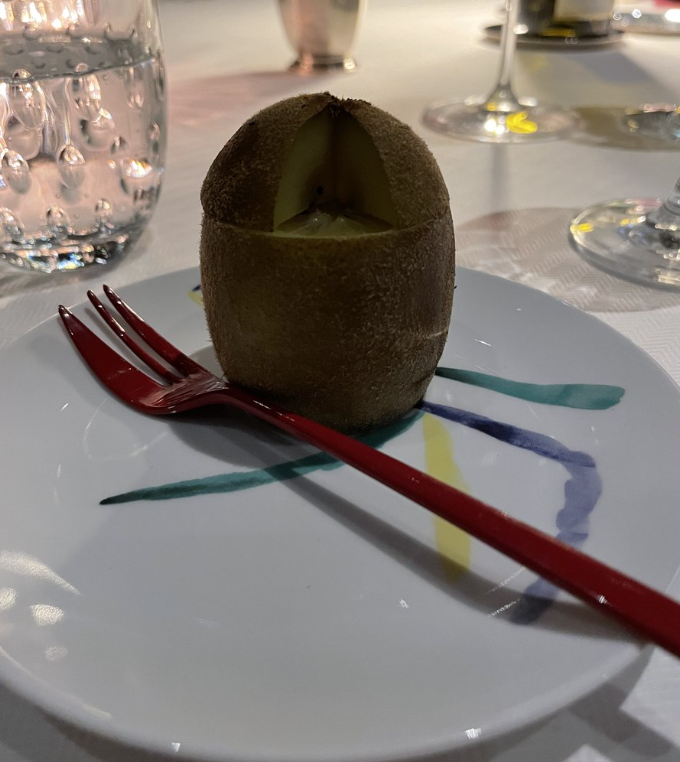
And then a final little snack, very reminiscent of the cobblestone-like cracker from the opening, a seedy and chocolatey bark, that we nibbled on with coffee and tea.
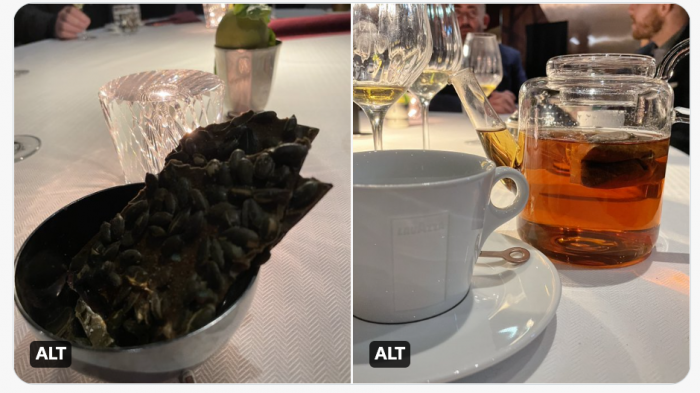
And thus the meal was concluded. A very lovely traipse through the cuisines and techniques that have made these chefs famous. It was not as full of theatrical “wows” or trickery as meals I’ve had at places like Field in Prague or Moto in Chicago.
I would compare it most to the meals we had in Spain with Carme Ruscalleda, or at Les Cols, but being in this ephemeral space of the temporary restaurant, ADMO didn’t have the same element of welcoming into a specific “home base” that is so central to those.
Instead, the ADMO meal is timeless because it is ephemeral. It captures this moment in time, this moment in the talents of the chefs and the situation of the world at large. It will never be recreated except in our memories.
